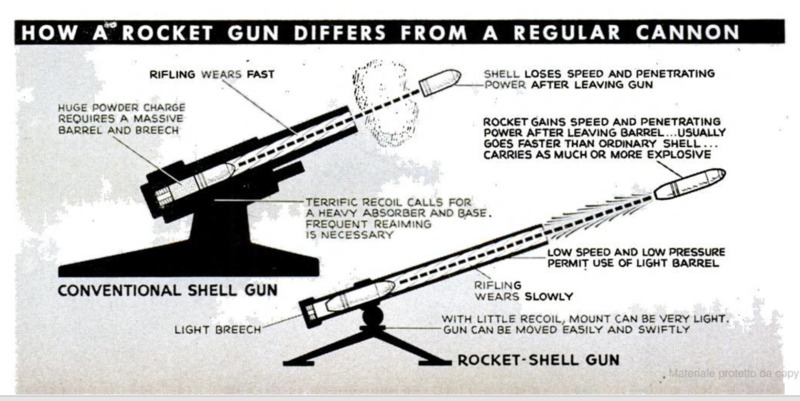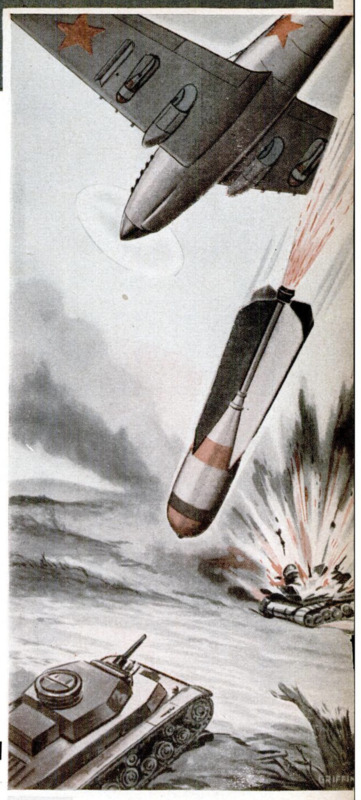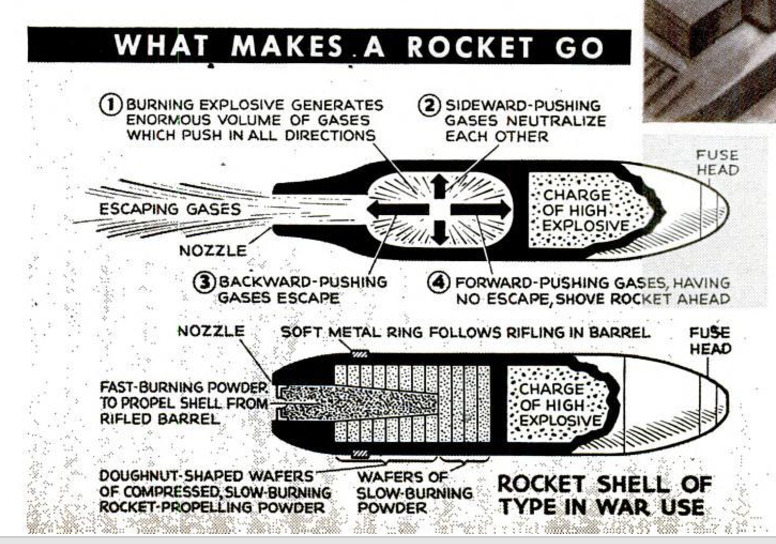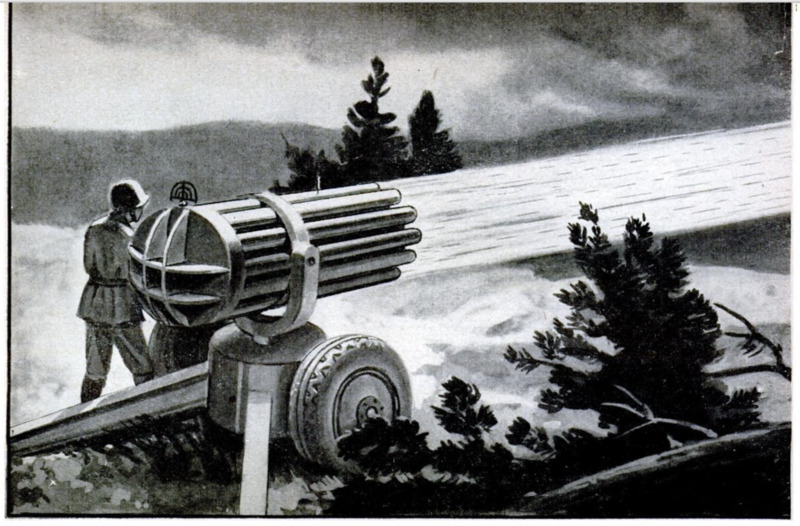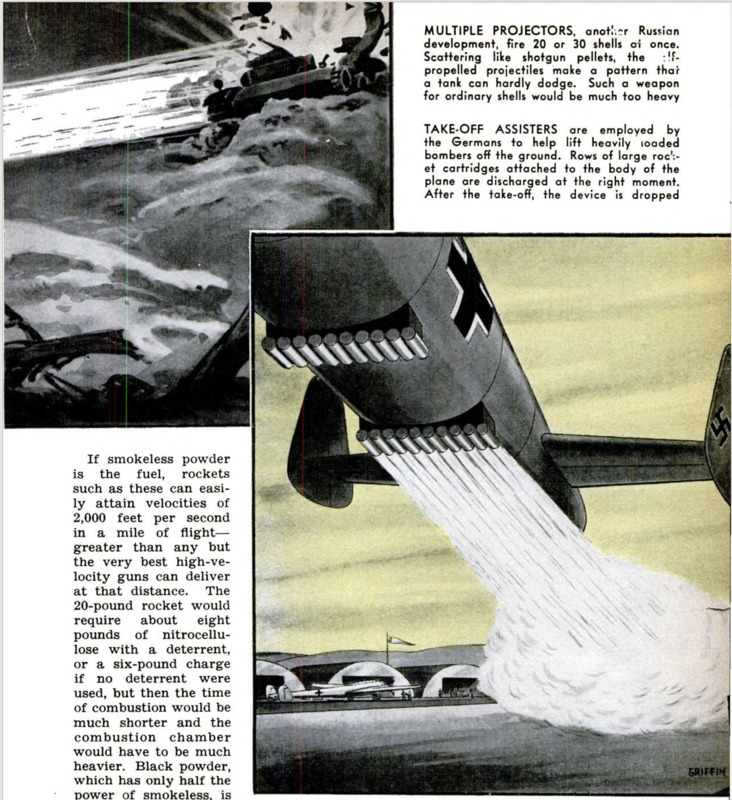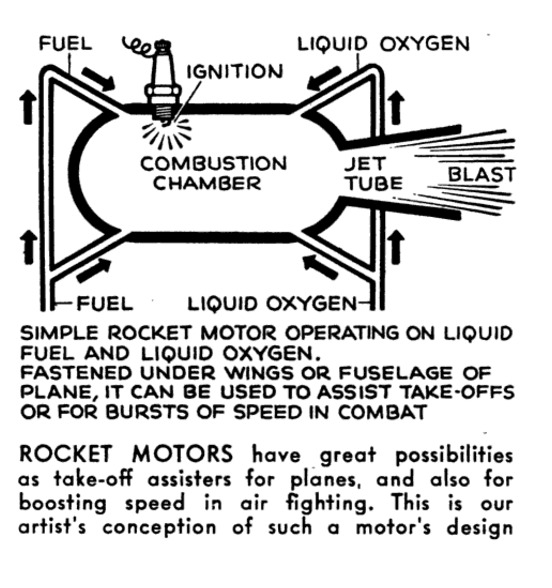-
Title (Dublin Core)
-
U. S. Experimental Rocket Guns and Aircraft Boosters
-
Article Title and/or Image Caption (Dublin Core)
-
Secret Weapons Blast Tanks and Planes. Buck Roger's world come true as warring powers devise self-propelled projectiles, fearsome-looking multiple launchers, and take-off boosters for aircraft
-
extracted text (Extract Text)
-
ROCKET weapons, a genuine “secret de-
velopment” of the present war, are
playing an increasingly important role
in military operations. Devices based on
the rocket principle are in use to discharge
projectiles, to trap and disable raiding air-
cratt, to increase the striking power of
bombs, and to produce an extra take-off
boost for planes carrying an overload of
fuel or explosives.
It is a safe bet that every major military
power is experimenting with rocket devices,
although all of them regard the work as
highly secret. Russia, Great Britain, and
Germany are definitely known to have rock-
et arms in service, and the success of these
weapons proves that the rocket principle
has made a striking come-back from a
position of relative scientific obscurity.
Rocket design has fascinated experimen-
tal scientists for centuries, and rocket weap-
ons in war probably antedate guns them-
selves. But the rocket as a military arm
went into a rather complete eclipse around
the time of our Civil War. During the First
World War, for instance, rockets were used
only on a limited scale for signaling and
other unspectacular purposes.
After the war, however, improvements in
the design of casings and fuel led to a
revival of interest in the rockets military
possibilities, and before 1939 it was known
that most of the major armies of Europe
were experimenting with the idea on a
small scale. War speeded the process up
in both the Axis and Allied camps, and now
various types of arms based on the rocket
principle are in use on many major battle
fronts.
Although German propagandists, from
Hitler down, have talked a lot about “secret
weapons,” the United Nations appear to
have a commanding lead in this new phase
of the armament race.
Since the summer of 1940 Britain has set
aerial traps for low-flying planes with the
PAC, a rocket device which carries aloft
a parachute and a trailing steel cable.
Another British weapon discharges ten ex-
plosive rockets simultaneously at raiding
aircraft.
Soviet Russia uses at least four rocket
arms: rocket bombs dropped by the Stormo-
vik ground-attack planes; a rocket gun
mounted aboard aircraft; a cable-trailing
device similar to the British PAC, and a
fearsome-looking instrument which can
discharge 30 explosive rockets at a time
at enemy tanks. The Germans are known
to have two rocket weapons in use, a
rocket bomb copied from the Russian model
and a quick-firing rocket weapon, some-
times, apparently erroneously, referred to
as a “mortar,” with six 6-inch barrels.
Rockets have found other uses, notably
in assisting planes to take off with heavy
overloads or from cramped spaces. The
RAF's Catafighter plane, carried on mer-
chant ships as protection against long-
range German bombers, is launched from
the deck by rocket power rather than by
a catapult.
Rocket take-off boosters are used by
the Nazi Luftwaffe on a small scale to
help overloaded Junkers 88's and Hein-
Kel 111-K's to get off the ground, and
are in an advanced state of develop-
ment in other air forces. In addition,
the rock-t principle, as applied to rock.
ettype engine-exhaust Jets, is em.
ployed to add to the speed of several
of the most recent pursuit planes.
The rocket obviously possesses an
inherent advantage that no gun can
match. Since It drives itself along, no
extreme power explosion is needed to
send it off, the tube or discharging
‘mechanism is not called on to stand
sudden violent pressure, nor is there
a sharp recoil requiring elaborate com-
‘pensating mechanism.
Therefore, rockets can be fired from
lightweight tubes mounted on relative-
ly flimsy firing platforms. As a re-
sult, such a weapon as the Russian
30-Barreled gun, which would be an
unworkable monstrosity in terms of
regular artillery, becomes entirely prac-
tical. And rocket weapons provide the
equivalent of heavy-caliber cannon
mounted in airplanes, as well as port-
able “one-man” field artillery.
‘The rocket is one of the very oldest
devices built upon the power of explo-
sives. It was invented in China in the
early part of the thirteenth century
and introduced in Europe soon after-
ward, whereas the gun probably was
not invented until the fourteenth cen-
tary.
Nevertheless, the rocket as a military
weapon has never enjoyed more than
‘occasional popularity, mainly because
it was more complicated to make and
control than gun projectiles. And until
now, at any rate, rocket projectors have
been shorter-ranged and far less accurate
than guns. The most notable historical
success achieved with rockets was at the
siege of Copenhagen in 1807, when Con-
greve rockets, developed in England dur-
ing the Napoleonic Wars, were used to burn
the city out and force its surrender. In
that bombardment the rockets were used
in much the same systematic way that a
modern commander who had control of the
air could use incendiary bombs to destroy
an enemy city.
Rockets of today fall into two classes,
solid-fuel and liquid-fuel. In either case,
the fuel is a “lazy” explosive which drives
the rocket by the reaction principle, akin
to the firing and recoil of a gun. When
the charge inside a rocket is fired, the gases
generated exert equal pressure in all di-
rections. Gases pressing backward, how-
ever, are permitted to escape by one or
more nozzles. In a gun they escape by driv-
ing the bullet through the barrel. The
only “escape” for the gases pressing for-
ward in the rocket is to drive the rocket
itself ahead. Similarly, the backward-
pressing gases in a gun cause the gun to
recoil.
The principal difference between a rocket
and a gun is that action and reaction take
place inside the projectile in the case of the
rocket, and outside it in the case of the gun.
The belief that the rocket is propelled by
the “push” of the gas jet against the air is
erroneous.
The military projectile rockets now in
use are all of the solid-fuel type, like the
traditional skyrocket. Liquid fuels do not
lend themselves to preloading, an essential
of operations on the battlefield.
At least three solid explosives have been
employed with success. England uses cor-
dite with an admixture of starch as a “de-
terrent” to keep the burning rate within
rocket limits. Prof. Robert H. Goddard, dean
of American rocketry, carried out success-
ful experiments with nitrocellulose (smoke-
less powder) fuel during the last war. And
the German six-barreled weapon fires rock-
ets powered with gunpowder. The German
mortar weapon is packed with gunpowder
wafers, solid wafers toward the head and
doughnut wafers toward the tail, with loose
powder filling the hole in the column of
doughnuts. When fired, the loose powder
flash-burns at once, producing a high ini-
tial thrust and acceleration.
As a general rule, rocket projectiles
weigh about a third more than standard
shells of the same caliber, for they must
carry not only driving and bursting charges,
but also the weight of the heavily rein-
forced combustion chamber, whereas the
shell has to carry only a bursting charge.
Even 50, the shell would generally have the
larger bursting charge. For example, a
three-inch shell weighs 13 to 15 pounds and
has a bursting charge of about two pounds
of high explosive; a three-inch rocket
would weigh perhaps 20 pounds, but its
bursting charge would be little more than
a pound.
If smokeless powder
is the fuel, rockets
such as these can easi-
ly attain velocities of
2,000 feet per second
in a mile of flight—
greater than any but
the very best high-ve-
locity guns can deliver
at that distance. The
20-pound rocket would
require about eight
pounds of nitrocellu-
lose with a deterrent,
or a six-pound charge
if no deterrent were
used, but then the time
of combustion would be
much shorter and the
combustion chamber
would have to be much
heavier. Black powder,
which has only half the
power of smokeless, is
not powerful enough to
reach the 2,000-foot
velocity, but it can reach 1,500 feet per sec-
ond at a mile.
In view of the relative inaccuracy of
rockets, a range of two miles is considered
fairly long. The German weapon, however,
by using a small rocket—50 pounds as com-
pared with 95 pounds for the standard six-
inch shell—and sacrificing much of the nor-
mal bursting charge, has an observed range
of 6,000 yards (31, miles).
Russia is the only nation known to have
succeeded in taking advantage of the light
weight and absence of recoil of rocket ap-
paratus in order to place large-caliber weap-
ons aboard planes. Such experiments,
however, are unquestionably under way in
other countries. The machine guns and
light cannon which are now standard on
aircraft are adequate for attacking other
aircraft. But 37-mm. guns (the largest
air cannon) are not powerful enough for
attacking ground targets, a function of in-
creasing importance for plancs. Larger
guns of conventional type, however, are im-
practical because of their weight.
The rocket’s inaccuracy has several
causes. The most troublesome is the fact
that no two fuel charges are exactly alike
in burning rate, or time, or power delivered
(thrust) from second to second. Even mi-
nor differences here make a considerable
difference in the point where the rocket
will land, because these differences are act-
ing over a considerable period of time. Sec-
ond, the center of gravity shifts as the fuel
is consumed, changing the rockets ballistic
characteristics. Third, as long as the fuel
lasts (from two to five seconds in most
cases, the rocket traveling on its momentum
the rest of the way just like a bullet), the
ejected gases build up a high-pressure area
immediately behind the rocket. Once the
fuel is gone, however, the high-pressure
area is replaced by the partial vacuum
‘which follows the ordinary projectile. Nat-
urally, this change has a decided effect on
the trajectory.
Some day, perhaps soon, rocket charges
will be identical and scientists will be able
to work out correction tables for the other
factors. Then the rocket will be as accur-
ate as the gun. But in the meantime “clus-
ter” weapons, such as the German weapon,
the Soviet antitank “battery,” and the
English AA rocket device, are effective.
Precision of fire is hardly required to hit
even a rapidly moving tank with one or
more of the 30 rockets the Soviet weapon
discharges.
Tnacourate as it is, the rocket has al-
ready added measurably to the accuracy of
one arm—the ground-attack bombers. The
oldest of the current series of rocket devices,
‘aside from PAC, is the rocket bomb. Stor.
movik planes used them effectively in No-
vember 1941 to help repulse the final Nazi
assault on Moscow.
The rocket bomb is
nothing more than an
ordinary bomb with
a small combustion
chamber and charge
in its tail. The pur-
pose is to add to the
bomb's velocity, there-
by increasing its im-
pact and penetrating
power, which vary as
the square of the ve-
locity, and adding to
the bombardier's ac-
curacy by flattening
the bomb's trajectory
and cutting its flight
time. The first Rus-
sian rocket bomb, a
220-pounder, accomplished this purpose
with an 11-pound charge of black powder
fired in a combustion chamber weighing
about 25 pounds.
Dropped from a plane traveling at 200
miles an hour at 1,000 feet, a conventional
220-pound bomb will reach its target in
three seconds with an impact velocity of
‘about 375 feet per second. One of the Sov-
fet missiles, however, would reach the tar-
got in 2.1 seconds with a velocity of more
Than 650 feet per second, and with impact
more than three times as great. The rocket
bomb would require an unnecessarily large
charge to exceed the terminal velocity of
the free-falling bomb (about 900 feet per
second): hence, it is not used for high-alti-
tude bombs. But it doubles the effective
ness of the dive bomber and ground-attack
In the years between this and the last
war, rocket experiments were carried on
principally by private individuals. Later
some of these men banded together in na-
tional societies, of which the German Rock-
et Soclety, founded 1921, the oldest, and the
American Rocket Society are the best
known. By and large, they were not nter-
ested in rocket projectiles. Their attention
was centered rather on high-altitude rocket
fight, with passenger-carrying stratoships
and ven interplanetary “space ships” as
their ultimate goals. Since solid fuels
proved unsuited to their objects, they be-
gan to develop liquid fuels, notably the
liquid oxygen-gasoline (pioneered by Dr.
Goddard) and liquid oxygen-alcohol. Al-
though neither will ever send a space ship
to the moon or even from New York to
Berlin, they will undoubtedly be of great
use in’ the near future in sending aloft me-
teorological rockets, one of the most impor-
tant potential uses of the rocket. They also
have great possibilities for assisted take-
offs in commercial-
airline operations.
Even before the war
began, considerable
work along this line
had been done. In
most countries, the
favored practice was
to build the fuel tanks,
combustion chamber,
and nozzles into the
trailing edge of the
aircraft's wings.
Liguid-oxygen fuels,
however, are imprac-
tical for military op-
erations. Germany has
abandoned the liquid-
fuel idea altogether
for the time being.
-
Contributor (Dublin Core)
-
Leonard Engel (writer)
-
Language (Dublin Core)
-
eng
-
Date Issued (Dublin Core)
-
1943-07
-
pages (Bibliographic Ontology)
-
50-54
-
Rights (Dublin Core)
-
Public Domain (Google digitized)
-
Archived by (Dublin Core)
-
Matteo Ridolfi
-
Alberto Bordignon (Supervisor)
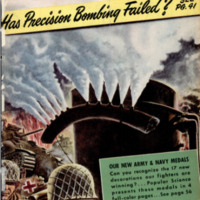 Popular Science Monthly, v. 143, n. 1, 1943
Popular Science Monthly, v. 143, n. 1, 1943

